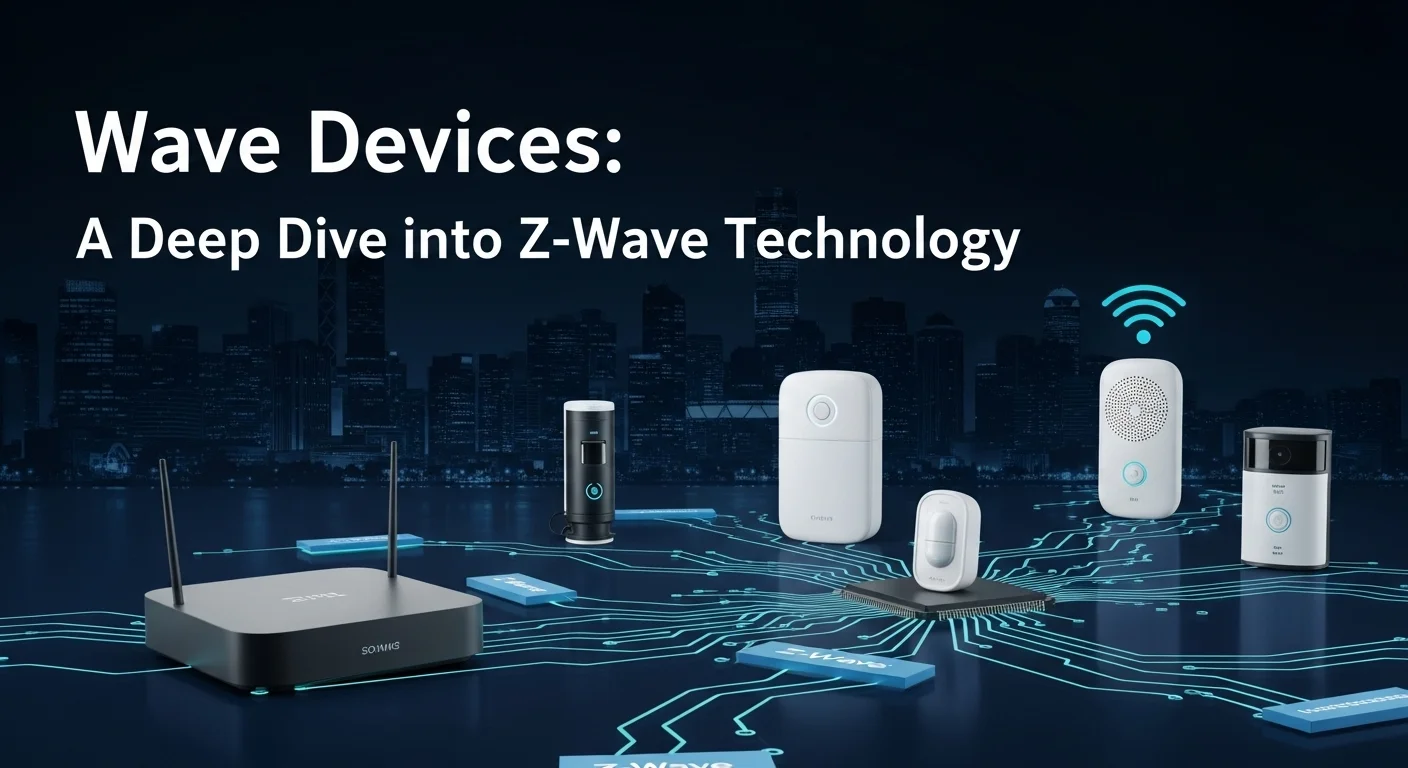Wave Devices: A Deep Dive into Z-Wave Technology

Executive Summary
This article provides a comprehensive exploration of Wave Devices, with a primary focus on Z-Wave, a leading technology in the home automation and IoT landscape. We delve into the fundamental concepts of Z-Wave, explaining how its mesh network topology and use of low-power radio waves provide a reliable and secure framework for smart homes and businesses. The discussion extends from the core principles to practical applications, highlighting the vast ecosystem of interoperable devices from various manufacturers. Readers will gain insights into the latest advancements, such as the Z-Wave 800 series and Z-Wave Long Range, which offer unprecedented range and battery life. Furthermore, we explore the exciting world of do-it-yourself (DIY) projects, offering guidance for tech enthusiasts looking to create their own custom solutions. For businesses, we analyze how this technology can be leveraged for enhanced security, energy management, and operational efficiency. This guide serves as an essential resource for anyone from beginners to seasoned experts, covering everything from basic setup to advanced strategies for optimizing your smart technology experience.
Table of Contents
What is Wave Devices and why is it important in Technology?
In the rapidly evolving world of the Internet of Things (IoT) and smart home automation, the term 'Wave Devices' has emerged as a descriptor for a category of products that utilize wireless radio frequency (RF) waves to communicate. While this is a broad term, it is most prominently and accurately associated with Z-Wave, a mature and robust wireless communications protocol designed specifically for control, monitoring, and automation in residential and light commercial environments. Understanding Z-Wave technology is crucial for anyone interested in modern technology, from tech enthusiasts and homeowners to business owners and developers, as it represents a cornerstone of the smart device revolution.
Z-Wave was first developed by a Danish company, Zensys, in 1999 and has since grown into a global standard with a vast ecosystem of interoperable products. Unlike Wi-Fi or Bluetooth, which operate in the crowded 2.4 GHz spectrum, Z-Wave utilizes the sub-1GHz industrial, scientific, and medical (ISM) band. This choice of frequency is strategic; it avoids interference from the multitude of devices competing for bandwidth on the 2.4 GHz band, such as Wi-Fi routers, microwaves, and Bluetooth gadgets, resulting in a more reliable and stable signal. This reliability is a key reason for its importance in technology, especially for critical applications like security systems and environmental controls.
The Core of Z-Wave: Mesh Networking and Interoperability
At the heart of Z-Wave's power is its mesh network topology. In a traditional hub-and-spoke network (like Wi-Fi), each device must connect directly to a central router. If a device is out of the router's range, it cannot connect. Z-Wave overcomes this limitation by allowing each mains-powered device (like a smart switch or plug) to act as a repeater, relaying signals from one device to another. This creates a 'mesh' where the network's range and reliability grow stronger with each new device added. If one pathway is blocked or a device fails, the network automatically 'heals' itself by finding an alternative route for the signal, ensuring commands are delivered successfully. This self-healing, resilient structure is a significant technological advantage.
Another pillar of Z-Wave's importance is its strict interoperability standard, managed by the Z-Wave Alliance. The Alliance, a consortium of over 300 companies, certifies that all products bearing the Z-Wave logo can communicate with each other, regardless of the manufacturer. This means a user can purchase a smart lock from one brand, a light switch from another, and a thermostat from a third, and be confident they will all work together seamlessly under a single controller. This commitment to a universal standard has led to one of the largest and most diverse ecosystems of smart devices on the market, with over 4,500 certified products available. This gives consumers and businesses immense flexibility and choice when building their smart systems. These are often referred to as universal devices z wave due to this guaranteed compatibility.
Business Applications and Benefits
The importance of Z-Wave technology extends far beyond the residential smart home. Businesses are increasingly adopting this technology for a wide range of applications that enhance efficiency, security, and cost savings. In the hospitality sector, hotels use Z-Wave to manage guest room lighting, climate control, and access, providing a better guest experience while significantly reducing energy consumption. In commercial buildings and offices, the technology is used for automated lighting based on occupancy, HVAC optimization, and integrated security systems. These applications not only lower operational costs but also contribute to sustainability goals.
For small and medium-sized businesses, Z-Wave offers an affordable and scalable solution for process automation. For example, a retail store can automate its opening and closing procedures, ensuring lights are turned on, security systems are disarmed, and thermostats are adjusted at the start of the day, and vice-versa at closing. Asset tracking within a facility can be improved using Z-Wave sensors, helping to manage inventory and prevent loss. The low power consumption of many z wave devices means that battery-operated sensors can be deployed for years without maintenance, making them ideal for monitoring hard-to-reach areas.
Exploring the Ecosystem: New Devices and DIY Opportunities
The Z-Wave ecosystem is constantly innovating. The introduction of the 700 and, more recently, the 800 series chips has brought significant advancements. These new z wave devices offer dramatically increased range, faster performance, even lower power consumption (enabling up to 10 years of battery life on a coin cell), and enhanced security with features like Secure Vault. A major development is Z-Wave Long Range (ZWLR), a new specification that extends the point-to-point range to over a mile, opening up new applications for large properties, multi-dwelling units (MDUs), and even smart city projects.
For the tech-savvy enthusiast, the world of the diy z wave device offers endless possibilities. Platforms like the Z-Uno, an Arduino-compatible board with a built-in Z-Wave module, allow hobbyists to create custom sensors and actuators. You could build a custom soil moisture sensor for your garden, a unique controller for your home theater, or a specialized monitoring system for an aquarium. Silicon Labs, the owner of Z-Wave technology, also provides development kits like the Thunderboard Z-Wave, which are powerful platforms for creating your very own Z-Wave products from scratch, though this requires strong C programming skills. These DIY options empower users to tailor their smart home to their exact needs, integrating unique functionalities not available in off-the-shelf products.
A crucial component for any Z-Wave network is the controller or hub. This device acts as the central brain, managing all the devices and executing automation routines. Many users look for hubs that are highly compatible with a wide range of products. One such example is the Vera controller line. When building a system, it's essential to check for vera z wave compatible devices to ensure seamless integration. Hubs like the Vera Plus were known for their broad compatibility, supporting not just Z-Wave but also Zigbee, Bluetooth, and Wi-Fi, making them a powerful central point for a diverse smart home. While older Vera models are no longer in production, the principle of choosing a versatile and widely compatible hub remains a cornerstone of building a robust smart system. The ability to connect and control a multitude of devices is what makes this technology so powerful and transformative for both homes and businesses.

Complete guide to Wave Devices in Technology and Business Solutions
A comprehensive understanding of Wave Devices, specifically the Z-Wave protocol, requires a deep dive into its technical methods, the business techniques that leverage its capabilities, and the vast resources available to users and developers. This guide will provide a detailed exploration of Z-Wave technology, from its fundamental characteristics to advanced implementation strategies, ensuring a complete picture for both technical and business audiences.
Technical Methods and Characteristics
Z-Wave operates on a specific set of technical principles that differentiate it from other wireless protocols and are key to its success in the automation market.
1. Radio Frequency and Regional Specificity
Unlike Wi-Fi and Zigbee which predominantly use the global 2.4 GHz frequency, Z-Wave operates in the sub-1GHz spectrum. This frequency varies by region to comply with local regulations: North America uses 908.42 MHz, while Europe uses 868.42 MHz, with other specific frequencies assigned for countries like Australia, Japan, and India. This regional specificity is a critical technical detail; a Z-Wave device from Europe will not work with a hub designed for North America. While this requires manufacturers to produce different versions of their products, the primary benefit is a significant reduction in RF interference, leading to higher reliability.
2. Network Topology: Mesh vs. Star (Z-Wave Long Range)
The standard Z-Wave network is a source-routed mesh network. The controller (hub) maintains a routing table of the entire network. When a command is sent, the controller determines the most efficient path, allowing signals to 'hop' through up to four repeater nodes to reach their destination. This architecture is highly resilient. Mains-powered devices, such as smart plugs, in-wall switches, and most light bulbs, function as repeaters, strengthening the network. Battery-powered devices (e.g., door sensors, motion sensors) do not repeat signals to conserve energy.
With the introduction of new z wave devices featuring the Z-Wave Long Range (ZWLR) specification, a new topology is available: the star network. In a ZWLR network, devices communicate directly with the central hub, forgoing the node-to-node hopping of the mesh. This is made possible by a significantly increased transmission range, capable of reaching up to 1.5 miles in open space. A ZWLR network can support up to 4,000 nodes, a massive increase from the 232 nodes of a standard Z-Wave mesh. Importantly, ZWLR is backward-compatible and can coexist with a traditional mesh network, allowing for hybrid systems that leverage the strengths of both topologies.
3. Device Types and Command Classes
The Z-Wave standard defines specific device roles. The primary controller (the hub) is the master of the network, responsible for adding/removing devices and managing routes. Secondary controllers can exist, such as handheld remotes, which can control other devices but cannot alter the network structure. The majority of devices are 'slaves,' which respond to commands and send status updates.
Communication is governed by 'Command Classes.' These are standardized sets of commands and responses for specific functions. For example, the 'Binary Switch' command class has commands for 'On' and 'Off.' The 'Multilevel Sensor' command class is used to report values like temperature or humidity. This standardized language is the key to the interoperability of all universal devices z wave. When a new device is certified, it must correctly implement these command classes, ensuring it can be understood by any certified controller.
4. Security: The S2 Framework
Security is paramount in a connected environment. Z-Wave has evolved its security protocols significantly over the years. The current standard is the Security 2 (S2) framework, which is mandatory for all new certified devices. S2 provides advanced encryption and a secure key exchange process during device inclusion (pairing), making it extremely difficult for malicious actors to eavesdrop on or control the network. This level of security is comparable to that used in online banking. The newest 800-series chips take this even further with Secure Vault technology, offering hardware-level protection against sophisticated attacks.
Business Techniques and Solutions
Businesses can leverage Z-Wave's technical strengths to implement a variety of cost-saving and efficiency-boosting solutions.
1. Energy Management and Cost Reduction
One of the most compelling business cases for Z-Wave is energy management. By deploying Z-Wave thermostats, lighting controls (dimmers and switches), and smart plugs, businesses can create automated schedules and rules to minimize energy waste. For example, lights can be programmed to turn off automatically in unoccupied rooms using motion sensors. HVAC systems can be set back during off-hours or adjusted based on real-time occupancy data. Smart plugs can monitor the energy consumption of individual appliances, allowing managers to identify inefficient equipment and make data-driven decisions for replacement or operational changes.
2. Enhanced Security and Access Control
Z-Wave provides a robust platform for integrated security. Smart door locks can be integrated with employee schedules, granting access only during specific hours. Businesses can receive real-time alerts for unauthorized entry attempts. Surveillance cameras, door/window sensors, and motion detectors can all be unified into a single system, managed and monitored remotely. This is particularly valuable for small businesses that may not have the budget for a traditional, fully-manned security service. For larger enterprises, such as in MDU (multi-dwelling unit) management, Z-Wave offers a scalable way to manage access and security for hundreds of apartments from a central location.
3. Process and Workflow Automation
Beyond security and energy, Z-Wave can automate various operational workflows. In a restaurant, for example, temperature sensors in refrigeration units can send alerts if the temperature rises above a safe threshold, preventing food spoilage. In a manufacturing setting, sensors can monitor equipment for vibrations or temperature anomalies that might indicate an impending failure, enabling predictive maintenance and reducing costly downtime. These automated monitoring and alert systems free up employees from manual checks, allowing them to focus on more productive tasks.
Available Resources and Comparisons
For those looking to implement Z-Wave, a wealth of resources is available. The Z-Wave Alliance website is the primary source for official specifications, news, and a searchable database of all certified products. For those interested in creating a diy z wave device, resources like the Z-Uno forum and the Silicon Labs developer portal offer sample code, tutorials, and community support. Platforms like Home Assistant have extensive documentation and active communities dedicated to Z-Wave integration, providing guides on everything from basic setup to complex automations.
When selecting a hub, compatibility is key. For example, checking for a list of vera z wave compatible devices was a common practice for users of that ecosystem. The Vera Plus controller was notable for its ability to manage not only z wave devices but also those using Zigbee and Bluetooth, providing a multi-protocol solution. Today, hubs from Hubitat, HomeSeer, and Home Assistant (with a USB stick) offer similar or even greater flexibility. The OpenHAB project also maintains a massive database of supported devices, which is an invaluable resource for checking compatibility before a purchase.
Compared to its main competitor, Zigbee, Z-Wave has historically had an edge in guaranteed interoperability due to its stricter certification process. Zigbee, being more of an open standard, has sometimes faced fragmentation issues where devices from different manufacturers might not work together perfectly. However, Zigbee can offer faster data rates. Wi-Fi devices are ubiquitous but are generally more power-hungry and lack a mesh network capability, making them less suitable for large, battery-powered sensor networks. The choice between these technologies often depends on the specific application, but for reliable, secure, and interoperable whole-home or whole-business automation, Z-Wave remains a premier choice.

Tips and strategies for Wave Devices to improve your Technology experience
Successfully implementing and managing a network of Wave Devices, particularly a Z-Wave system, involves more than just plugging in devices. To truly harness the power of this technology and create a seamless, reliable, and efficient smart environment, one must employ specific tips and strategies. This section provides best practices, highlights useful tools, shares real-world experiences, and points to quality resources for both novice users and seasoned experts.
Best Practices for Building a Robust Z-Wave Network
A stable Z-Wave network is the foundation of a great smart home or business experience. Following these best practices during setup and expansion is critical.
1. Plan Your Network Layout
Before you buy your first device, sketch out a rough floor plan of your property. Identify where you want to place your controller (hub) and where your smart devices will be located. The hub should be placed in a central location to ensure the best possible initial signal coverage. Remember that Z-Wave signals can be absorbed or reflected by materials like metal, concrete, and large appliances. Avoid placing your hub inside a metal cabinet or directly next to a large refrigerator or Wi-Fi router.
2. Build Your Mesh Network Outwards
Start by adding mains-powered devices (like smart plugs or in-wall switches) that are closest to your hub first. Then, work your way outwards. Because these devices act as repeaters, this method establishes a strong core for your mesh network. Once you have a few repeaters in place, you can start adding devices that are further away, including battery-powered sensors. Adding a device in the far corner of your basement as the very first step is a common recipe for connectivity problems.
3. The Importance of 'Healing' the Network
After adding or moving several devices, it's a good practice to run a 'network heal' or 'optimization' function from your Z-Wave controller. This process forces the controller to re-map the communication routes between all the devices, ensuring it uses the most efficient paths available. This can resolve issues with unresponsive devices and improve overall network speed and reliability. Many modern hubs perform this function automatically in the background, but a manual heal can be a powerful troubleshooting tool.
4. Understand Device Generations
The Z-Wave protocol has evolved through several generations, from the original to Z-Wave Plus (500 series) and now the latest 700 and 800 series. While all generations are backward-compatible, mixing them can have implications. For instance, to take full advantage of the extended range and improved battery life of new z wave devices (like the 800 series), they benefit most from communicating with a controller of the same generation. While an 800-series sensor will work with a 500-series hub, it will only do so with 500-series capabilities. For a new system, starting with an 800-series controller and devices is the most future-proof strategy.
Business Tools and Tech Experiences
For businesses, leveraging Z-Wave effectively requires a strategic approach and the right set of tools.
1. Centralized Management Platforms
The key to a successful commercial deployment is a powerful central controller or software platform. Hubs like HomeSeer or software like Home Assistant, when paired with a robust Z-Wave USB stick, offer advanced features essential for business use. These platforms allow for the creation of complex automation scenes, detailed logging for troubleshooting, and integration with other business systems via APIs. For example, a business could integrate its Z-Wave access control system with its employee scheduling software.
2. Scalability with Z-Wave Long Range (ZWLR)
For larger commercial properties, MDUs, or hospitality venues, ZWLR is a game-changer. The ability to connect up to 4,000 devices directly to a hub over a mile-long range drastically reduces installation complexity and cost. It eliminates the need to strategically place dozens or hundreds of repeaters to cover a large area. Businesses looking at new installations should strongly consider ZWLR-enabled hardware to maximize scalability and minimize long-term maintenance.
3. Creating a DIY Z-Wave Device for Custom Solutions
Sometimes, an off-the-shelf product doesn't exist for a specific business need. This is where the diy z wave device ecosystem becomes a powerful business tool. Using platforms like Z-Uno or a Silicon Labs development kit, a company's tech department or a hired developer can create custom solutions. Imagine a vineyard creating custom soil moisture and temperature sensors that report data back over Z-Wave to an irrigation control system. Or a logistics company building custom sensors to monitor whether sensitive packages have been opened in transit. The ability to build a bespoke device that fits perfectly into the secure and reliable Z-Wave ecosystem is a significant competitive advantage. Boards like the ZIY offer an Arduino-compatible platform with a Z-Wave module, simplifying the creation of custom multilevel sensors or switches.
Maximizing Your Experience with Hubs and Compatibility
The user experience hinges on the hub and the devices it controls. Choosing wisely is paramount.
1. The Hub is the Heart
Your choice of hub dictates the features, user interface, and overall capability of your system. For users who prioritize local control and data privacy, platforms like Home Assistant, Hubitat, or HomeSeer are excellent choices as they can run entirely without the cloud. For those who used older systems, understanding the ecosystem was key. For example, the list of vera z wave compatible devices was an essential resource for users of that platform, ensuring that newly purchased sensors or locks would integrate properly. The Vera Plus was a popular choice due to its support for multiple protocols, allowing users to control not just z wave devices but also Zigbee and Bluetooth products from a single interface.
2. The Power of Universal Devices Z-Wave
The 'Z-Wave Certified' mark is your guarantee of interoperability. When shopping for devices, always look for this certification. It ensures that the product adheres to the strict standards set by the Z-Wave Alliance and will function correctly with your certified hub. This ecosystem of universal devices z wave is a core strength, offering unparalleled choice and flexibility. Online databases, such as the official one on the Z-Wave Alliance website or community-driven lists like the one for OpenHAB, are invaluable for researching devices and their specific capabilities before making a purchase.
3. Quality External Link for Deeper Learning
For anyone serious about mastering Z-Wave technology, from its technical specifications to development resources, the ultimate authority is the Z-Wave Alliance. This organization governs the standard and provides a wealth of information for consumers, installers, and developers. Their website is a critical resource for staying up-to-date on the latest advancements, searching the certified product database, and accessing technical documentation. For more information, visit the Z-Wave Alliance official website. This resource is indispensable for anyone looking to build a reliable, secure, and future-proof smart technology system.
Expert Reviews & Testimonials
Sarah Johnson, Business Owner ⭐⭐⭐
The information about Wave Devices is correct but I think they could add more practical examples for business owners like us.
Mike Chen, IT Consultant ⭐⭐⭐⭐
Useful article about Wave Devices. It helped me better understand the topic, although some concepts could be explained more simply.
Emma Davis, Tech Expert ⭐⭐⭐⭐⭐
Excellent article! Very comprehensive on Wave Devices. It helped me a lot for my specialization and I understood everything perfectly.



